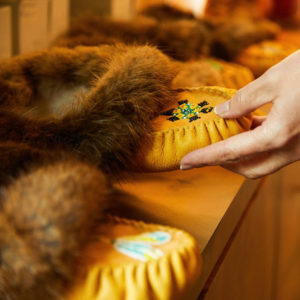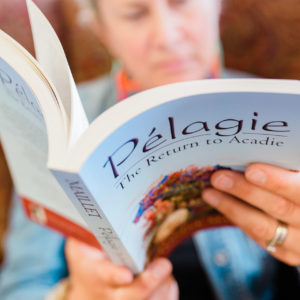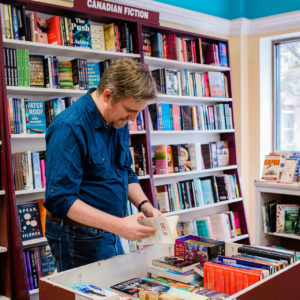
I-Chun Jenkins
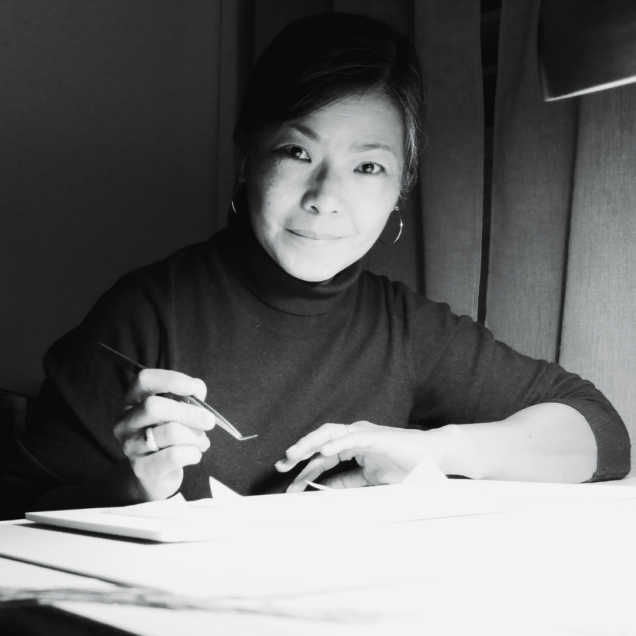
I-Chun Jenkins, an honours graduate in Textile Design from the New Brunswick College of Craft and Design in 1994, began her career in the fibre arts weaving scarves and shawls using yarn that she dyed in the traditional Japanese wrap dyeing technique known as IKAT. Pieces that she created using this technique ensured that no two creations were identical.
Between 1992 and 1997, she received numerous grants and awards for her work both as a student and as a professional fibre artist. During this period Ms. Jenkins’s products were featured in the Art Gallery of Ontario gift store.
In 1998 I-Chun decided to focus all her creative energy on raising a family. In 2010 she purchased a small café in downtown Fredericton. Her pleasant personality and the creative food menu made the café a success.
However, by 2016 the yearning to get back to what she loved to do was so much that she decided to sell the café. She set up a home studio and began the process of getting back into weaving and creating with fibre. I-Chun was never one to follow tradition nor wanted to duplicate any piece of work, so she looked at working with non-traditional weaving material and ways to create one of kind pieces of art. Her love of magazines, nature and protecting the environment led her to an artist’s logical conclusion. She decided to reuse the magazines by using the pages as her material source for her weaving and artwork. Pages are meticulously cut, sliced, weaved, crocheted, or folded together to create a very unique piece of art, a one-of-a-kind piece of artwork.
What led you to become an artist?
To be honest, I have always felt drawn to the artistic world, even as a young child. The world around me was vivid with colours and my imagination would transform these colours into patterns and shapes. As I transformed from a child to a young adult, my passion for putting the images in my mind to paper or some other type of medium became the dream I wanted to chase. Circumstances throughout my life would creep in and prevent me from pursing this dream full-time, but I would eventually be drawn, no pun intended, back to creating artwork.
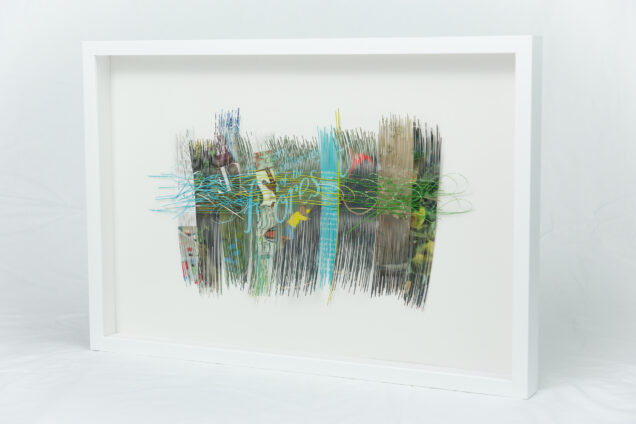
What drew you to weaving?
During my first week of attending the New Brunswick College of Craft and Design, we (students), were able to visit many of the different types of studios that the college had to offer. One day, walking by the textile studio, I was captivated by the atmosphere emanating from the room. There was soft jazz music playing the background and the smell of the freshly polished wooden looms instantly drew me into the room. I knew nothing about weaving, but it was the first time as an artist, I felt home and a place where my creative mind could explore endless possibilities.
How did your training and experience help you to create and innovate in your artistic practice?
Weaving seemed to come very naturally to me as a person who likes to focus on just one task at a time. My instructor, Susan Judah, was very particular and I would even say demanding perfection from each piece of weaving created no matter how simple or complicated the piece was. This was a perfect fit for me, as I come from an Asian culture and following strict protocols and instructions was part of my life growing up. I carried these practised methods of weaving throughout my time at the college and later in life as a jeweller and particular as a weaver when I started working with different types of medium.
What stimulates you most about your practice?
For me, I find challenging myself with different types of mediums to weave to be very stimulating. Particularly when I incorporate very untraditional material into my artwork. Traditional weaving is still fun and exciting, but figuring out colour combinations using different materials, dying my own threads and yarns, and then trying to transform the image in my head to an actual piece of artwork is the real driving force that keeps me up at nights, but in a good way.
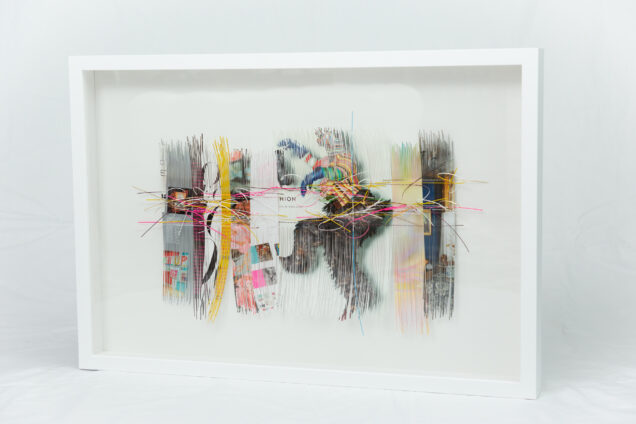
How has living and working in New Brunswick helped and/or inspired you on your journey?
New Brunswick is a wonderful place as we are surrounded by nature. Nature is amazing and the beauty that one can see in this province is astounding. We have oceans, beaches, forests, incredible rivers, and lakes, and all within an hour or two from my home. Simply taking a walk in the woods behind my house provides incredible amounts of inspiration for my artwork. We are lucky to experience the four seasons in this province and each season provides a different perspective of the landscape as it changes from season to season.
What motivates your creativity?
Nature! I am always in awe of how this planet creates such beautiful masterpieces. The varying shades of colour between mosses, rivers, oceans, trees, leaves, animals, this list goes on, provides such an immense intensity in me that I sometimes feel like I am experiencing sensory overload. A simple walk in the woods behind my house in the wintertime reveals so much contrast between the white snow on the ground, the grey bark of the trees, the white patches of lichen on the branches and tree trunk, the green old man's beard moss hanging from the branches of an old dying tree, to the brilliant greens of the needles of a fir tree, have provided the creative inspiration behind many of my pieces.
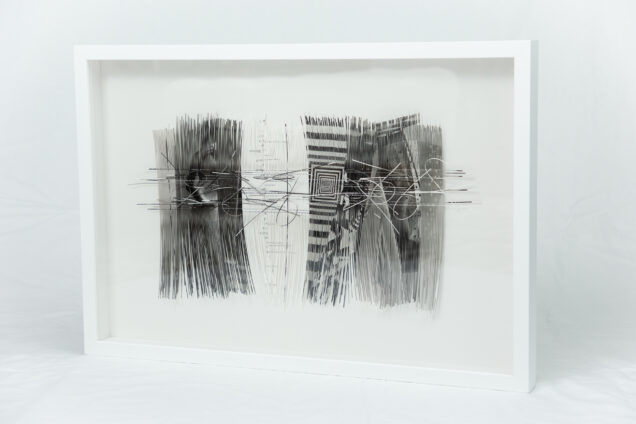
How does your creative process unfold as you create an artwork?
This is a complicated question for me as I never really have a process that I follow. Typically, I will see something in nature that has a unique colour, or shape, or maybe a combination of both. I will then take a picture or make a mental note of what I have just witnessed and how it has affected me emotionally. Sometimes nothing comes from these experiences but if I find myself dwelling on the experience or going back to look at the photograph I took, I then start to think about how I could translate that into the type of artwork that I do.
If I feel that I can create something from this encounter with nature, then I start to think about what medium would work best, if I can weave it using paper or yarn, does it work and capture my interpretation of what I experienced as a wall piece or could it be made into wearable art, such as a scarf. However, during the actual creation of the piece, my emotions or interpretation of the experience may change, as I continually reflect on the image in my mind or the photograph of what I captured that day, and this may alter the original intent or vision of the piece.
Why do you think it’s important to make art and pursue an artistic career?
I believe keeping art alive in our culture is very important. Particularly coming from an Asian background, art pieces were a way of capturing our cultures’ history. The world we live in today is much different, where technology allows anyone to be an artist by using software, and now even artificial intelligence to create artwork. However, I believe true artistry will still come from people who create with their hands and rely on emotions and feeling to develop the artwork, not for Instagram likes, but to truly express their creativeness and emotions that inspired the art that they are creating.
What have you learned about yourself and New Brunswick’s artistic community through your work?
To be honest, the artistic community of New Brunswick is very supportive, but also very critical, especially when an artist uses a non-traditional medium or style to create artwork in their perspective artistic area of training. As an artist who is always pushing the boundaries of traditional weaving by using varying types of mediums and techniques, and in many cases creating pieces, that draw bewildered expressions from people, I have had to develop a thick skin, and that did not come overnight! There was a lot of self-doubt, questioning myself on why I should I continue, self-reflection on my career choice, but then I realized for an artist like me to be truly successful, experimenting with mediums and pushing what can be accomplished beyond the traditional limitations is what defines me as an artist. As my artwork developed, there were many in the art community, not only artists, but also the local, national, and international art connoisseurs, who purchased my pieces, that gave me the support and the motivation to continue the path I have created today.
What do you think is the impact of artists’ work on communities?
That is difficult to answer as an artist's work moves, as it should, people differently. I believe there should always be artwork and artists in communities to provide cultural reference, of the past and present events that shape that community. As well, artists, or at least the artists I know, are a wonderful example of humanity and can express their emotions through their artwork. This artwork is displayed at events or shows and draws together members of the community, where for a brief instance, they may forget the troubles of the world, or be given an opportunity to reflect differently on their lives or the world, based on the artist’s exhibition.

Describe what you are most proud of in your career.
I have been fortunate to have many wonderful things occur in my career as an artist but, I think having a few of my pieces purchased by Global Affairs Canada Visual Art Collection and being proudly displayed in Abu Dhabi, United Emirates and Harare, Zimbabwe are certainly highlights.
What advice would you give to people who want to become artists?
Marry someone with a good career, LOL. All kidding aside, the path to becoming a successful artist (financially) is challenging. The rates which galleries charge to sell your work, shipping costs, material cost, are all contributing factors in making it difficult to sell artwork at a profit. However, if the passion is there and you truly want to be an artist, then you will be successful, not only monetarily, but also in life. You must believe in what you do and believe in yourself. Self-doubt will always creep in, we are artists and our own worst critics, so you must learn to push past those thoughts and remember why you wanted to be an artist. Just let your creative mind flow and you will find the path you need to be on.
